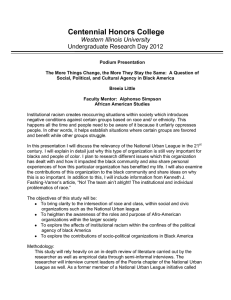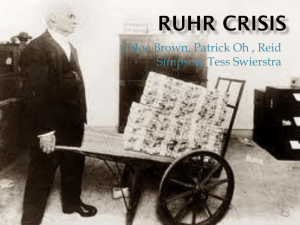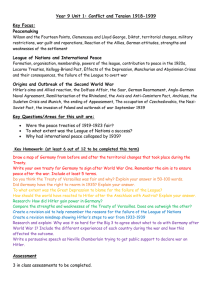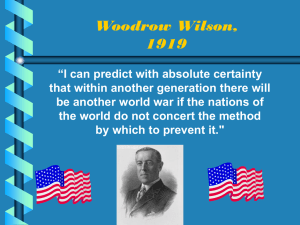9389 HISTORY MARK SCHEME for the May/June 2015 series
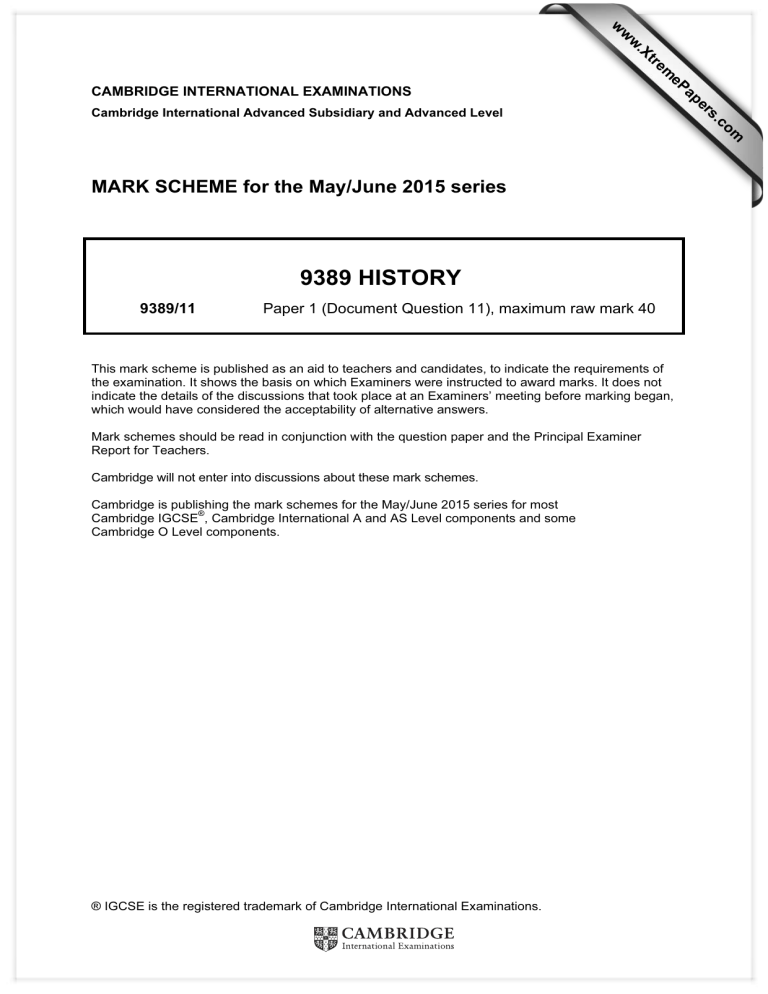
www.XtremePapers.com
CAMBRIDGE INTERNATIONAL EXAMINATIONS
Cambridge International Advanced Subsidiary and Advanced Level
MARK SCHEME for the May/June 2015 series
9389 HISTORY
9389/11
Paper 1 (Document Question 11), maximum raw mark 40
This mark scheme is published as an aid to teachers and candidates, to indicate the requirements of the examination. It shows the basis on which Examiners were instructed to award marks. It does not indicate the details of the discussions that took place at an Examiners’ meeting before marking began, which would have considered the acceptability of alternative answers.
Mark schemes should be read in conjunction with the question paper and the Principal Examiner
Report for Teachers.
Cambridge will not enter into discussions about these mark schemes.
Cambridge is publishing the mark schemes for the May/June 2015 series for most
Cambridge IGCSE
®
, Cambridge International A and AS Level components and some
Cambridge O Level components.
® IGCSE is the registered trademark of Cambridge International Examinations.
Page 2 Mark Scheme Syllabus Paper
Cambridge International AS/A Level – May/June 2015
Generic levels of response
Part (a)
Level 4: Makes a developed comparison
9389 11
[12–15]
Makes a developed comparison between the two sources, recognising points of similarity and difference. Uses knowledge to evaluate the sources and shows good contextual awareness.
Level 3: Compares views and identifies similarities and differences [8–11]
Compares the views expressed in the sources, identifying differences and similarities. Begins to explain and evaluate the views using the sources and knowledge.
Level 2: Compares views and identifies similarities and/or differences
Identifies relevant similarities or differences between views/sources and the response may be onesided with only one aspect explained. Alternatively, both similarities and differences may be mentioned but both aspects lack development.
Level 1: Describes content of each source [1–3]
Describes or paraphrases the content of the two sources. Very simple comparisons may be made
(e.g. one is from a letter and the other is from a speech) but these are not developed.
Level 0: No relevant comment on the sources or the issue [0]
Part (b)
Level 5: Evaluates the sources to reach a sustained judgement [21–25]
Answers are well focused, demonstrating a clear understanding of the sources and the question.
Reaches a sustained judgement about the extent to which the sources support the statement and weighs the evidence in order to do this.
Level 4: Evaluates the sources [16–20]
Demonstrates a clear understanding of the sources and the question. Begins to evaluate the material in context, considering the nature, origin and purpose of the sources in relation to the statement. At the top of this level candidates may begin to reach a judgement but this is not sustained.
Level 3: Uses the sources to support and challenge the statement [11–15]
Makes valid points from the sources to both challenge and support the statement in the question.
These comments may be derived from source content or may be about the provenance/nature of the sources.
Level 2: Uses the sources to support or challenge the statement [6–10]
Makes valid points from the sources to either support the statement in the question or to challenge it.
These comments may be derived from source content or may be about the provenance/nature of the sources.
Level 1: Does not make valid use of the sources [1–5]
Describes the content of the sources with little attempt to link the material to the question.
Alternatively, candidates may write an essay about the question without reference to the sources.
Level 0: No relevant comment on the sources or the issue [0]
© Cambridge International Examinations 2015
Page 3 Mark Scheme
Cambridge International AS/A Level – May/June 2015
Syllabus
9389
Section A: European Option
Liberalism and Nationalism in Italy and Germany, 1848–1871
The 1848 Revolutions in Germany
Paper
11
Indicative Content
(a) To what extent do Sources A and B agree on what the aims of the reformers in
Germany should be? [15]
There is quite a contrast between the two sources. The liberals in Source A specify various aims such as representation by estates, free trade, a free press and also raise concerns over defence issues. Their hostility to censorship and security is also clear. There is an emphasis on ‘common German interests’, even if not sustained. Source A has less of a focus on national representation than does Source B. In its second paragraph, it states a very clear set of liberal reforms, with the reference to the ‘just demands of the people’ – though not in terms of national goals.
In Source B the ‘German’ nation is stressed, as is the theme of co-operation between the people and the existing states. There is also an anti-war theme. The reference to ‘freedom’ for the German nation is very strong, but there is less reference to the ‘people’. It is much less ‘liberal’ in many respects. National representation should focus on defence (a similarity to A) and other issues like ‘self-administration’ of the existing states. It is much more of a conservative, middle class document, reacting to the news from France, and the impact of that radical outburst is clear. Source A is a more abstract programme of liberal reform, drawn up before the year of revolutions, whereas Source B combines similar reforms with a concern to develop national unity, but only through the existing state structure.
(b) ‘Nationalism was the principal cause of the revolutions in Germany in 1848.’ How far do Sources A to D support this view? [25]
Context: By the 1840s, the conservative rulers of German states were facing two challenges to their reactionary government: economic, as a widespread depression caused considerable hardship among the peoples of Germany, and political, as a new generation of middle class reformers began to demand liberal and national reforms. These challenges are reflected in the four sources A to D. In terms of the unity of Germany, the 1815 German Confederation was dominated by the conservative rulers of the two great German powers, Austria and
Prussia, e.g. the 1819 Carlsbad Decrees repressing freedom of expression. A form of economic union was developing in the form of the Zollverein, dominated by Prussia, which did stimulate the development of an industrial middle class.
Demographic and cultural changes were bringing about significant changes in German society, changes which resulted in the revolutions of 1848–49. In 1847, the King of Prussia,
Frederick William IV decided to call a state Diet to help authorise new taxes. He dissolved it within a few months, causing no real protest as he did so. Then came 1848, the year of revolutions. The German revolution was the last of the revolutions of the spring of 1848, following popular revolts in Italy, France and Austria. The Germans were slow to revolt.
© Cambridge International Examinations 2015
Page 4 Mark Scheme
Cambridge International AS/A Level – May/June 2015
Syllabus
9389
Paper
11
Analysis: The four sources should enable candidates to develop some clear arguments for and against the assertion. Source C is the strongest in supporting the hypothesis, arguing that Germans travelling abroad wanted to identify themselves as Germans as much as they did with their particular states. Strongest against the hypothesis is Source D, which argues that economic depression and exploitation were causing hardship among the working class.
This hardship would lead in turn to political unrest across Germany.
Sources A and B have nationalist elements within them, though they are not predominant; liberalism is just as significant, perhaps more so in A. The opening words of Source A presumably refer to the Prussian United Diet, a very conservative body dependent upon the goodwill of the Prussian King. Source A’s most direct reference to national matters is reference to ‘common German interests’ but that is only to explain the current situation and not to make proposals for strengthening national institutions. It refers to the limited nature of the federal armed forces but without any sense of dissatisfaction or wanting something more effective. In fact, it considers cutting the costs of the army.
There is more evidence of national concerns in Source B but not a great deal more. It talks of national honour, of the need for ‘a national representation’ but goes on to say that addressing these national concerns must always be done in co-operation with the various states of
Germany as well as its peoples. While both Sources A and B suggest that national demands would be a cause of the forthcoming revolution, neither suggest that it was the principal cause of that upheaval.
Evaluation: All sources predate the German revolutions of 1848. Some might therefore question whether these sources can explain events which were yet to happen. However, the causes of 1848 must be found in events before then. If none of the sources clearly support the argument that nationalism was the principal cause of the 1848 revolutions, they still require evaluation to assess the reliability of their arguments.
Source A, written by middle class liberals, almost certainly Prussian given the reference to the Diet, focused on longstanding liberal demands – including reducing the costs of the army.
It is narrowly self-serving as a statement of liberal demands. Source A is reliable; in helping to decide whether nationalism was the main cause of the 1848 Revolutions in Germany, it has little value.
Source B is very similar. The 51 men assembled in Heidelberg were either self-appointed or chosen by unrepresentative state assemblies rather than being directly elected. They will not be revolutionaries. The effect of the news of the revolution in Paris on these men is hard to assess. They might be enthused by the revolutionary spring or they might be alarmed. They show little enthusiasm for any national unity; if anything, the opposite is the case. Sources A and B support each other. They show how unrevolutionary, how unnationalistic the potential leaders of the revolution were. They are reliable in helping to challenge the assertion.
Source C is a surprise. A ruler of a small state would not be expected to show nationalist tendencies because a national German would threaten his own self-interest. Thus this is reliable in helping to show that nationalism was more a part of German debate in the 1840s than might have been expected.
Source D is also a surprise. Here a Silesian aristocrat is highlighting the economic distress which caused the pre-revolutionary protests across Germany. Nationalism gets no mention.
The unusual nature of these two sources gives them a greater reliability, even if they point in opposite directions. Taken together, none of the evaluated sources support the hypothesis.
For that, evidence must be sought elsewhere.
© Cambridge International Examinations 2015
Page 5 Mark Scheme
Cambridge International AS/A Level – May/June 2015
Section B: American Option
The Origins of the Civil War, 1846–1861
The Republican Party in 1860
Syllabus
9389
Paper
11
(a) Compare and contrast Sources A and D as evidence about the process of drawing up the Republican Party’s national platform at its 1860 convention. [15]
Source A shows the process to be slow – ‘through Wednesday night and most of Thursday’ – and complicated – ‘its own unwieldiness’ necessitating a sub-committee to speed things up.
That the process eventually worked was to the credit of John Kasson who worked tirelessly to reconcile differences, according to the source. Source D confirms that a sub-committee of five was set up though without explaining clearly the reasons for doing so. It identifies both
John Kasson and the author of Source A, Horace Greeley, as members of the subcommittee. In fact, Kasson and Greeley were last men standing on the second morning.
According to Source D, Greely left to send the platform to the New York Tribune , which he edited, while Kasson stayed behind to finalise the platform before reporting it to the full committee. Source A is unusual in that its author makes no mention of the author’s role in the events he describes, which makes it more reliable. Source D comes from a book written much later; it adds details to Greeley’s account without ever contradicting it. Together, the two sources provide a fairly reliable account of the process of drawing up the Republican
Party’s national platform.
(b) ‘The Republican Party in 1860 was deeply divided.’ How far do Sources A to D support this view? [25]
Context: In 1860 the Republican Party was six years old. Its parents were Whigs, Know-
Nothings and Northern Democrats. This complex parentage and recent birth were bound to cause tensions and strains within the new party. The main issue which had brought them together was slavery, an issue reignited by the Compromise of 1850 and the Kansas-
Nebraska Act of 1854. The party was bound by an opposition to slavery. However, there were great divisions about how to deal with the problem of slavery. Conservatives, usually ex-Democrats, thought it should be contained to existing slave states and not allowed to expand into the territories of the West.
The Republican Party’s candidate for president in 1856, John C Frémont, was a Free Soil
Democrat. Radicals argued that the federal government should do everything within its power to abolish slavery as soon as possible; their leaders were politicians such as Charles
Sumner and Thaddeus Stevens and journalists such as Horace Greeley. Some historians identify moderate Republicans who sought a middle way between the two; Lincoln was one such Republican. Ex-Democrats and ex-Whigs also disagreed over economic policies, such as tariffs and infrastructure. The recession of 1857 helped to accentuate these differences.
© Cambridge International Examinations 2015
Page 6 Mark Scheme
Cambridge International AS/A Level – May/June 2015
Syllabus
9389
Paper
11
Analysis: Sources A and D, writing about the same event, illustrate the unity of the
Republican Party – though Source D, right at the end, shows a division over tariff policy, at the time a very significant issue. Source C shows how divided the party is – at least in New
York State. The viewpoints of these three sources are easy to identify. Source B is more problematic. It shows an uneasy, uncomfortable unity. The party is united by a single plank or platform. The plank is being carried by an African American, presumably a slave, who suggests that carrying Lincoln on such a narrow platform is really hard, and a leading abolitionist, who is much more positive. Lincoln himself worries that the 1860 platform is the most difficult he has had to straddle, i.e. support. According to Source B, unity is rather fragile.
Evaluation: Horace Greeley is mentioned in all four sources: once as the source itself, once in a cartoon and twice as part of sources. Sources A, B and D show him to be a key member of the Republican Party while Source B reveals him as editor of the New York
‘Tribune’ . Thus he is journalist as well as party politician, features which bring into question his reliability as author of Source A. He is bound to portray the party platform in positive terms. Source C further undermines Source A as it shows that Greeley has personal ambitions for federal government office. However, Source C comes from the New York
‘Herald’ , which almost certainly would have been a rival to Greeley’s newspaper.
Furthermore, Source A is more fact than comment. In addition, Source D , on the same subject, confirms Greeley’s account. Source B , the cartoon, shows Greeley doing some heavy lifting in support of Lincoln’s candidacy, in combination with an African-American. We have no details of where the cartoon was published; was it either the Tribune or the Herald ?
That the partner of Greeley was an African-American, almost certainly a slave, whether actual or fugitive, at a time when slaves played little or no direct part in Republican Party politics, suggests the cartoon is critical of the party. The emphasis on Lincoln’s relatively humble origins might support this view.
Source C is certainly critical of the Republican Party in New York State, which it argues was deeply divided, especially between Greeley and Seward, who was the leading radical candidate for the Republican Party’s presidential candidacy. Perhaps that personal animosity was untypical of other state Republican parties.
The final sentence of Source D , however, suggests that division was more widespread on issues other than slavery. Thus the evaluated evidence in support of divisions within the
Republican Party is strong: it was divided over candidates and policy. Whether it was deeply divided is more arguable: opposition to slavery united Republicans more than divisions over tactics and leadership divided them.
© Cambridge International Examinations 2015
Page 7 Mark Scheme Syllabus Paper
Cambridge International AS/A Level – May/June 2015 9389 11
Section C: International Option
The Search for International Peace and Security, 1919–1945
Germany and the League of Nations
Indicative
(a) Compare and contrast the views expressed about the League of Nations by Hitler in
Source A and Stresemann in Source D. [15]
Hitler (Source A) argues that the League of Nations is weak and based on the false assumption that nations would voluntarily agree to settle disputes in a ‘Peace Court’. Such an assumption, he claims, is naïve. He feels that disputes will always be settled by the relative strength of the parties involved; the strong will always be victorious over the weak.
He justifies this by claiming that it is a reflection of God`s will.
Stresemann (Source D) clearly disagrees, arguing that the League of Nations offers the best chance for future peace and avoiding a repeat of the ‘ catastrophic war ’ [WWI]. The League offers the prospect of mutual disarmament and free trade between nations, leading to ‘ peace, freedom and unity ’. Stresemann argues that this is better than countries ‘ using our national strength against each other ’, in complete contrast to Hitler`s view that national strength is the best way to settle disputes.
Hitler was speaking in 1923, at a time when there was no prospect of Germany being invited to join the League. Hitler was trying to gain support for a newly-established political party with ultra-nationalistic policies. To most Germans, the League of Nations was seen as part of the
Treaty of Versailles, a Treaty which had been imposed on a weakened Germany by the victorious powers of WWI. Hitler consistently argued that the Treaty of Versailles should be overturned, and this would inevitably mean rejection of the League of Nations. He sees a fundamental weakness in the League; without an army of its own, it lacks the power to force countries to accept its decisions. A strong country would, therefore, be able to ignore the
League. Hitler`s aim was to make Germany strong again. He was a ‘ politician of the revenge school ’ (as mentioned in Source B).
Stresemann belonged to what Source B describes as the ‘ peaceful elements of the country ’.
The speech marked Germany’s formal admission into the League of Nations, so it is inevitable that he would speak positively about the League. By 1925, Germany remained weak and isolated, suffering from economic problems and the continuing problem of meeting reparations payments. It remained vulnerable to possible French aggression (as in the occupation of the Ruhr in 1923). The Locarno Treaties of 1925 led to the prospect of ending
German isolation and improving relations between Germany and France. In joining the
League of Nations, Germany was demonstrating its commitment to peaceful relations with other European nations. Under the terms of the Treaty of Versailles, Germany had been forced to disarm. Britain and France had refused to do the same. Stresemann clearly saw the
League of Nations as the vehicle for ensuring that all of the major European powers would disarm, making Germany less vulnerable.
© Cambridge International Examinations 2015
Page 8 Mark Scheme
Cambridge International AS/A Level – May/June 2015
Syllabus
9389
Paper
11
(b) How far do Sources A to D support the view that it was not in Germany’s interests to join the League of Nations? [25]
Context: The League of Nations was established by the Paris peace settlement. Germany, as a defeated nation, was initially not allowed to become a member. Perhaps inevitably, therefore, the League was treated with mistrust by the majority of German people. It was equated with a treaty which was imposed on Germany, and was viewed as a tool of the victorious powers, notably Britain and France. France, in particular, fearing a revival of
German power, was determined to keep Germany weak and isolated. Germany faced major economic problems, not helped by the requirement to meet reparations payments. Its weakness and vulnerability were highlighted when France occupied the Ruhr in 1923.
By 1925, the situation facing Germany had changed. The Dawes Plan (1924) seemed to offer a solution to the problem of reparations, while Britain was encouraging the recovery of the German economy (for vested interests – Germany provided a lucrative trading partner).
Moreover, France seemed willing to forge improved relations with Germany, as demonstrated by the success of the Locarno Treaties in 1925. As a result, Germany was invited to join the League of Nations, formally gaining admission in September 1926. This was indicative of an apparent reduction in tension between the main European powers.
Analysis: Main support for the hypothesis comes from Sources A and C. Hitler (Source A) argues that the League is weak, with no power to enforce its decisions on nations in dispute.
Therefore Germany, in its weakened state following the Treaty of Versailles, would gain no protection from more powerful nations by joining the League. The implication of Hitler`s speech is that Germany needs to become strong enough to protect its own interests and impose its own will rather than relying on a weak and ineffective League of Nations.
The law professor (Source C) argues that the League of Nations is not popular with German people and that any German government which suggested joining would face a major outcry leading to political instability. The main aim of German foreign policy, the source claims, is to revise the Treaty of Versailles and regain territory lost as a result of it. Joining the League would force Germany to accept the Treaty of Versailles (including the hated War Guilt clause), and this time it would be voluntary rather than imposed upon Germany by the victorious powers. Moreover, Germany would have to accept the loss of territories required by the Treaty of Versailles. Source B, though advocating German membership of the
League, also suggests that the majority of German people would be opposed to it.
The hypothesis is challenged by Sources B and D, and, to some extent, C. Source B argues that it would be in the ‘ best interests of the world and of Germany herself ’ for Germany to join the League. Joining the League would prove to the rest of the world that Germany does not want more wars or revenge for its defeat in WWI and the imposition of the Treaty of
Versailles. The League, it argues, offers the best prospect for future world peace, settling disputes by negotiation rather than war. In Source D, Stresemann argues that a repeat of
WWI would be undesirable and that the League offered the best prospects of avoiding this. It would allow world-wide disarmament, trading agreements and equality between nations.
Although Source C gives reasons why Germany might be reluctant to join the League, it begins by suggesting that it would be in the country’s best interests to do so – as a country weakened by the Treaty of Versailles and economic problems, the League would offer some form of security and end Germany’s isolation.
© Cambridge International Examinations 2015
Page 9 Mark Scheme Syllabus Paper
Cambridge International AS/A Level – May/June 2015 9389 11
Evaluation: Source A is Hitler speaking in 1923, at the height of Germany’s economic problems for which he held the Treaty of Versailles responsible. He was seeking support for his ultra-nationalist policies. To Hitler, joining the League would merely compound this betrayal and confirm Germany’s weakness and vulnerability. Germany needed to be strong again and this meant overturning the Treaty rather than reinforcing it by becoming members of the League. As an expression of extreme right-wing views, this is reliable. As evidence for or against the hypothesis about German interests in joining the League of Nations, it is most unreliable.
Source B is written by a German socialist who believed that Germany should take the peaceful route to resurgence. This meant ending German isolation by demonstrating to other countries that Germany had no desire to seek revenge for the Treaty of Versailles by starting another war. Joining the League would be the best way to avoid the prospects of a future war. The writer argues that the majority of German people favour peace, that they oppose those of the ‘ revenge school ’ such as Hitler. Thus Source B challenges the assertions of
Source A. The source also understands that the people are mistrustful of the League because of its origins. Writing in 1924, the author believes that Germany would soon be invited to join the League, as happened as a result of the easing of tensions due to the
Dawes Plan and the Locarno Treaties. Thus contextual knowledge gives credence to Source
B.
As with Source B, Source C was written in April 1924 when prospects of Germany being invited to join the League had grown. As with Source B, the writer explains why the majority of Germans were opposed to joining the League. This source provides an even-handed analysis of Germany and the League in the mid-1920s. It shows the advantages which
Germany would gain from membership while also outlining the price it would have to pay to achieve them. Sources B and C together provide a more measured account of Germany and the League of Nations than does Source A. However, they were written at a time of greater optimism as recovery from the calamities of 1923 took hold and were thus likely to be more positive.
Source D is a speech made more than two years later, at the time when Germany formally joined the League of Nations. This followed the easing of tension between European nations as a result of the Locarno Treaties in 1925. Stresemann was addressing the League to mark
Germany`s formal admission, so it is inevitable that he would be positive about the League and Germany`s commitment to it. This context also makes the speech most unreliable as evidence to support or deny the hypothesis. The source claims that the German government is fully committed to encouraging ‘ peace, freedom and unity ’ and rejects the notion of ‘ Right above Might’ (Source C) which Hitler was advocating in Source A. Of these contrasting views, in the longer term Hitler’s prevailed as he came to power in 1933 and withdrew
Germany from the League.
Thus there are four contrasting views, two from right-wing politicians, one from a left-wing perspective, the fourth from an academic. While the academic’s analysis could be seen as the most reliable, the reality of German politics meant that the most extreme and unreliable view eventually won the day.
© Cambridge International Examinations 2015

